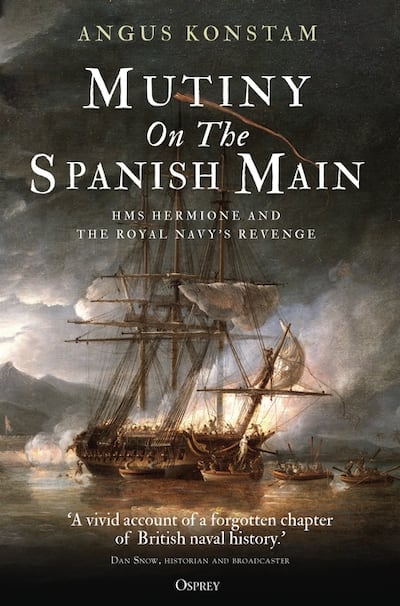Late in the evening of September 21st, 1797, as the frigate HMS Hermione was patrolling the waters of the Caribbean, her crew rose up in bloody mutiny. These were men pushed to their limits by a tyrannical and unstable captain, who meted out floggings with a manic zeal. That night, off Puerto Rico, something snapped.
A little after 11pm, after steeling themselves on stolen rum, a group of armed sailors crept aft to the captain’s cabin, clubbed the marine sentry to the ground, then burst through the door. Capt Hugh Pigot was in his cot, where he was slashed, hacked and stabbed, before his mutilated body was thrown out of the cabin’s great stern windows. This was only the start of a night of bloody murder and revenge.
The mutineers murdered the frigate’s officer of the watch, and his body was thrown over the side. Meanwhile, armed guards held the other officers prisoner. Many of the Hermione’s crew might have been reluctant to join the revolt. However, by doing nothing about it, they became fully implicated in the mutiny.
Fuelled by stolen rum, the crew then turned on their remaining officers. One by one they were dragged on deck, murdered and then pitched overboard. Three more lieutenants, a midshipman, the purser, the surgeon, the carpenter, the gunner, the boatswain and even the captain’s clerk were all slaughtered during the course of the night. Only two popular officers survived the carnage, one of whom was David Casey, a 19-year-old midshipman from Co Cork.
Afterwards the ringleaders sailed south to La Guaira in Venezuela, where they handed the warship over to the Spanish. As Britain was at war with Spain and France at the time, they had now added treason to their list of crimes.
In La Guaira, Casey and five others were handed over to the Spanish as prisoners of war. Eventually they were exchanged for Spanish prisoners, and were able to rejoin the fleet. This of course meant that they were able to give an account of what had happened on the night of the mutiny. Just as importantly, they could now identify the mutineers.
When news reached the admiralty, a full-scale manhunt was launched. In the end 33 mutineers were caught and 24 of them were hanged. Casey and the other witnesses played their part by naming the mutineers, despite most having changed their identities. Casey was also willing to say if one of them hadn’t been an active participant and had simply been swept along with the others.
So, the teenage midshipman from Co Cork helped spare the lives of several of his former shipmates. Casey remained in the navy until 1839, although he never rose beyond the rank of lieutenant.
Three Irishmen
Of the 18 ringleaders, three were Irishmen: surgeon's mate Lawrence Cronin (35), from Belfast; seaman Robert McReady (23), from Derry; and boatswain's mate Thomas Nash (25), from Waterford. We don't know much about McReady, who merely helped incite his shipmates to violence. However, Cronin, an ardent supporter of the French revolution, was the one whose words whipped the mutineers into a bloodlust with shouts of "Kill them all". Nash was the worst of the three. He took part in the murder of Capt Pigot, and the officer of the watch.
After the mutiny Cronin was rumoured to have set himself up as a doctor in Caracas, and McReady disappeared completely. Nash was the only one of the trio who was caught, and in the process he helped cause a major international incident.

In February 1799 an American schooner put in to Charleston, South Carolina. Word soon reached the British consul that Thomas Nash was on board, and he was arrested. Britain and the United States had an extradition treaty, and after a lengthy court hearing Nash was handed over to the British authorities.
Nash was taken to Jamaica, where he was identified and put on trial. He was found guilty, and on August 19th was hanged from the yardarm of a British warship. This caused an outcry in the US, as Nash had falsely claimed American citizenship. Americans also resented the royal navy's heavy-handedness in stopping its merchant ships in search of mutineers.
What was quickly seen as a new British outrage – the extradition of an American citizen – caused widespread anger in America. Public fury over this became a major factor in President John Adams’s defeat at the hands of Thomas Jefferson in the presidential election the following year. So a young sailor from Waterford inadvertently helped change the course of American history.
Historical quest
As a historian, my interest in this story was first piqued in the late 1980s, during a visit to the National Maritime Museum in Greenwich. While there I spotted a small painting by Thomas Pocock, The Cutting Out of HMS Hermione, 1799. I thought I knew my naval history, but I had never heard about the recapture of the Hermione from the Spanish in October 1799.
I was intrigued, and became determined to find out more. That’s where the historical quest began. Along the way I discovered a lot more about the most brutal mutiny in Britain’s naval history, and I gradually unearthed a tale involving all the treachery, violence, murder, betrayal and sweet revenge one could wish for. What I never managed to do was to find out what happened to Lawrence Cronin and Robert McReady. The trail went cold after the two fugitives changed their names.
One day we might find out the truth; a yellowed document, perhaps,, unearthed in an attic in Boston or Caracas that links the past to the present. Until then, the fate of these two Irish mutineers will remain a mystery.
Angus Konstam is the author of Mutiny on the Spanish Main: HMS Hermione and the Royal Navy's Revenge, published by Osprey









